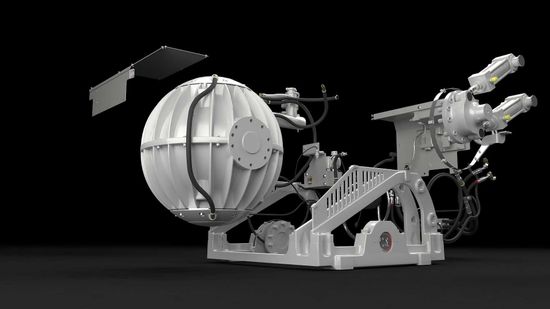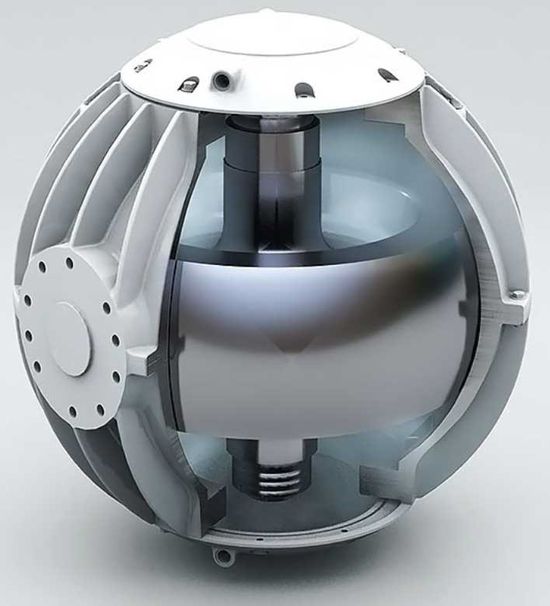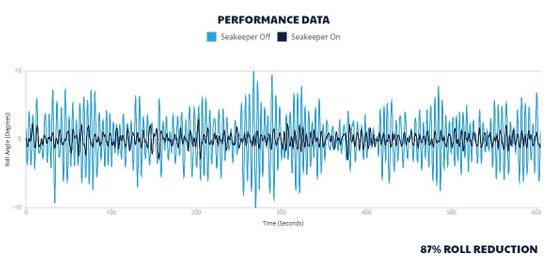Seakeeper Gyro Stabilization For Smaller Boats
If you desire more information about the Seakeeper or would like to buy one of the units below, click here…
Seakeeper
Seakeeper is the best-known company building control moment gyroscope stabilization systems for boats (Mitsubishi and Quick are also in the game) and they make the eyebrow-raising claim that one of their units can reduce rocking and rolling by up to 90-percent.
We stepped aboard one Seakeeper-equipped boat after the next and put their claim to the test by measuring side-to-side roll with an inclinometer. When the results were compared, testing with the Seakeeper disabled versus with it active showed a net roll reduction of around 90-percent. That was on three different boats, ranging in size from 30 to 61 feet.
How does it work? Inside the Gyro, there’s a big flywheel that spins to create torque. The flywheel spins in a vacuum and the unit is cooled with a glycol/seawater system, so that the flywheel can spin at up to around 10,700 rpm and at over 550 mph. This naturally produces angular momentum—in other words, torque. One way to picture the forces at work is to think of a spinning top. As long as it’s spinning quickly, momentum keeps it upright and level. Since the Seakeeper is powered and it always spins at a controlled rate, that momentum is always present.

Active Control
The momentum, and the torque it creates, counteract the force of a boat’s rolling motion. As the boat rocks (or tries to rock) in the waves, hydraulic arms tilt the orb containing the flywheel fore and aft. This naturally applies the force of the torque to port and starboard. Seakeeper calls this “Active Control.”
An onboard computer senses rolling motions and tells the arms when and how far to tilt the orb to effectively counter the rolling motion of the boat. As the computer monitors each rolling cycle, it constantly adjusts the orb and the torque it is creating to effectively counteract that side-to-side motion.

The same Control Moment Gyroscope technology used by Seakeeper comes from spacecraft attitude control systems, which are being used at this very moment on the International Space Station. Four of them, in fact. Our advice: don’t worry too much about understanding the physics behind it. Instead, get on a boat with a Seakeeper and feel the difference for yourself.
What about the cost?
Yes, the cost is substantial, but maybe not as bad as one would guess. Retrofitting a boat with gyro-stabilization costs on average about five percent of the value of the boat. On relatively small, new boats in the 30-foot range, which are specifically designed to carry a compact Seakeeper unit, the cost can be expected to run about $25,000. Considering what a 30-footer costs these days, that doesn’t sound like a big price to pay to get a boat that barely rocks and rolls.
In larger boats they can cost as much as $200,000 in new construction, depending on the size of the unit.

It should be noted that the Seakeeper and similar systems can put a significant strain on a boat’s structure. Some new boats are now being designed and built to accommodate it but retrofits aren’t always simple. Though a gyro can be dropped into just about any boat over 30 feet, installing one is definitely not a DIY job – this is something best left to the professionals.
Observations
BoatTEST tested the Seakeeper when it first came out over 10 years ago. We said at the time it clearly dampened roll when the boat was at rest by about 50%, but we did not have sophisticated measuring devices at the time. Now we do. Also, the company is into its second generation of gyro stabilizers and they are better than ever. Also coming with each unit is its own monitor, so owners can see exactly what the roll is – and see what the reduction is – which is considerable.
The concept of gyro stabilization has pretty much been accepted by most of the industry and more and more boat builders are putting them on the standard or on their options list. They are particularly popular with the builders of lightweight boats which can bob like corks in light conditions.
Cure for Mal de Mer? Obviously, the prime objective is to solve the age-old problem of seasickness, which is generally regarded as being sensitive in the inner ear. We have also felt that is important to not overindulge the night before and have a solid, non-greasy breakfast. All of this is very unscientific, but the Seakeeper is very scientific and it certainly works to stabilize all sizes of boats.